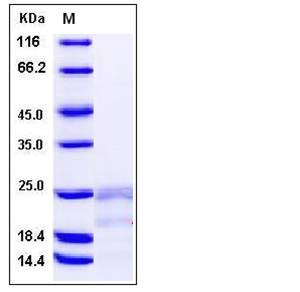Human IFN-gamma / IFNG / γ-IFN Protein
IFG,IFI,IFN gamma,Interferon Gamma
- 100ug (NPP3981) Please inquiry
| Catalog Number | P11725-HNAS |
|---|---|
| Organism Species | Human |
| Host | CHO Stable Cells |
| Synonyms | IFG,IFI,IFN gamma,Interferon Gamma |
| Molecular Weight | The secreted recombinant human γ-IFN consists of 143 amino acids and has a predicted molecular mass of 16.7 kDa. γ-IFN migrates as two bands with apparent molecular mass of 21&25 kDa probably due to different glycosylation. |
| predicted N | Gln 24 |
| SDS-PAGE |  |
| Purity | > 92 % as determined by SDS-PAGE |
| Protein Construction | A DNA sequence encoding the human γ-IFN (NP_000610.2) (Met 1-Gln 166) was expressed and purified. |
| Bio-activity | Measured in antiviral assays using WISH human amnion cells infected with vesicular stomatitis virus (VSV) . The EC50 for this effect is typically 0.1-0.5 ng/mL. |
| Research Area | Cancer |Invasion microenvironment |Angiogenesis |Cytokine & Receptor |Interferon & Receptor |Interferon | |
| Formulation | Lyophilized from sterile PBS, pH 7.4 1. Normally 5 % - 8 % trehalose and mannitol are added as protectants before lyophilization. Specific concentrations are included in the hardcopy of COA. |
| Background | IFN gamma, also known as IFNG, is a secreted protein which belongs to the type I I interferon family. IFN gamma is produced predominantly by natural killer and natural killer T cells as part of the innate immune response, and by CD4 and CD8 cytotoxic T lymphocyte effector T cells once antigen-specific immunity develops. IFN gamma has antiviral, immunoregulatory, and anti-tumor properties. IFNG, in addition to having antiviral activity, has important immunoregulatory functions, it is a potent activator of macrophages, and has antiproliferative effects on transformed cells and it can potentiate the antiviral and antitumor effects of the type I interferons. The IFNG monomer consists of a core of six α-helices and an extended unfolded sequence in the C-terminal region. IFN gamma is critical for innate and adaptive immunity against viral and intracellular bacterial infections and for tumor control. Aberrant IFN gamma expression is associated with a number of autoinflammatory and autoimmune diseases. The importance of IFN gamma in the immune system stems in part from its ability to inhibit viral replication directly, and most importantly from its immunostimulatory and immunomodulatory effects. IFNG also promotes NK cell activity. |
| Reference |
